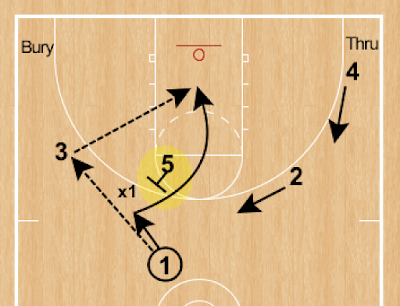1 - Isolations via primary action or options from many other sets (e.g. Horns stagger or Iverson cut)...occupying the help side works
Breakdown: one-on-one, box drills
2 - Pick-and-roll, give-and-go, post entry and back cut
Breakdown: two-on-two
3 - UCLA cuts, Celtics "triple action", Bucks off-ball screen actions
Breakdown: three-on-three (small-sided group play)
4 - Horns downscreens, GSW downscreen basket cut, Bulls ballscreen options
Breakdown: shell drill emphasizing offense and defense
What do I mean by numbers? Run offense according to the number of players involved initially.
1 = isolation for your best individual attackers; that doesn't preclude options
We're a very right-handed team. We might elect to run isolation from horns from the right slot (above).
Maybe, we align 1-4 high, with a myriad of options. We could run 3 through and get isolation for 5 as a "starter" play.
Or we could run a spread set and let 1 try to isolate off the dribble.
2 makes the simplest actions for "two man game"
Dribble Handoffs are another easy action to get multiple attacking options.
Back cuts from the wing are an attractive option.
3 isn't a crowd.
Among the most obvious is the UCLA option cut. We expect x1 to jump to the ball, making the cut above more probable.
From horns, the post entry and off-ball screen is conceptually easy. The
Celtics like to run other options off the "high triangle" including handoffs pick-and-roll.
The Bucks liked to enter the post and then downscreen for Antetokounmpo (4). Any time you can get a great player the ball that seems like a good idea. Also, the 1-4 screen challenges the automatic switch.
4 or more.
I'm a fan of horns with paired downscreens.
Golden State runs horns downscreen into a basket cut.
The Bulls of Tom Thibodeau liked to run the high ball screen with options for 4 or 3 depending on the actions of the help. These create open shots and/or closeouts.












